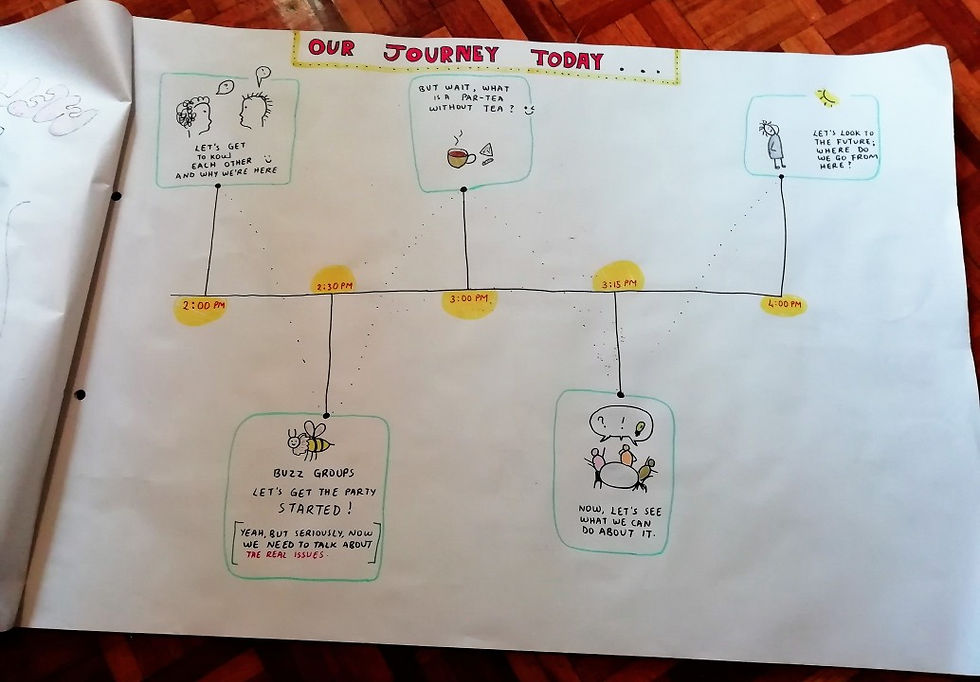Hippos, fishies and milkshakes: lessons from a prototyping journey
- Jacqueline Wahome

- Aug 30, 2019
- 3 min read
Updated: Jun 30, 2020
Design thinking and co-creation seem to be flying around a lot lately in a buzz-wordy kind of way. I myself interacted with this for the first time when I had the privilege to attend a design-thinking workshop in New Delhi, organised by Civil Society Academy and Welthungerhilfe. This was the same workshop that gave us (Goal 16) the chance to pitch an innovative idea to support social activists in their work. Thankfully, we won a grant to help us prototype our idea to see if there is a real need for it and whether it is practically applicable. This is a short story of the lessons we've learnt so far in this prototyping journey.

Lesson 1: Ask, don't assume
In the wise words of Ernesto Sirolli, "Want to help someone? Shut up and listen!" (TED Talk here). Seeing that the focus group for our prototype is Civil Society Organisations (CSOs) working in Kenya, the very first realisation we came to was that NGO projects can really be out of touch with reality. And the question we asked ourselves was, why? So my partner Tommi and I got a bunch of guys working with CSOs and asked them this question. And the answer was simple: rarely are beneficiaries ever involved in the project conceptualization and development phase.

The result? Implementation becomes a total nightmare. Either your target beneficiary rejects the project outright, or simply participates because you offered some monetary incentive. However, at the end of it all, there is zero impact, and you realise that a whole lot of money was literally just poured into a black hole. Or in Ernesto's case, eaten by hippos from the Zambezi. (I would really recommend you watch the TED Talk, it's hilarious and sobering at the same time.)
Lesson 2: What's the job to be done?
In this video, Prof. Clayton Christensen describes the story of a McDonald's milkshake. The short version is, the food chain wanted to increase their milkshake sales. They did everything right; called focus groups and asked them to test new recipes and give recommendations for improvement. The test group gave very good recommendations, which McDonald's applied. But the milkshake sales still did not go up.

At this point, the good Professor introduces a new concept - the jobs to be done theory. He suggested that, instead of asking customers how to improve their milkshakes, McDonald's should instead ask them, "what job does this milkshake do for you?" For the rest of the story, follow this link.
What we learnt from this was that it doesn't matter how good you make your product; people will only buy into it if it fulfills a specific need. In other words, they will hire your product to do a specific job.
Lesson 3: What's your fishie?

Ideally, the co-creation process should culminate in a workable solution that addresses a specific need, which has already been established by involving the target user. This video about a lucky iron fish teaches us that it's not enough just to identify the need and come up with a viable solution; it won't work if it comes in the wrong shape or form.
In this story, a social entrepreneurship organisation noticed widespread anemia in some parts of Cambodia. Their solution was scientifically accurate: anemia is caused by an iron deficiency in the blood, so to solve it, iron should be added to the diet. As you watch the video, you will notice that though they had identified a specific need and offered an accurate solution, it was still rejected by the target user. Why was this? Because they failed to take into account the local culture and customs. Once they did this however and improved their prototype based on this, their solution received a very positive reception.
So, in summary...
As we develop projects and work on solutions in whatever field, let's always remember the Zambezi hippos, the McDonald's milkshake, and the lucky iron fish.
For a more in-depth conversation on design thinking or graphic illustrations, please feel free to reach out in the comment section or through a direct message.
You missed the pitch and want to see the full event again? Watch now!
Never miss an update! Subscribe to our Newsletter.
Please note: This post appeared originally on LinkeIn.
About the author:
Jacqueline Wahome is a co-founder of Goal 16 Governance Platform. Inspired by the SDG goal no. 16, Goal 16 aims to create strong institutions by providing training and research solutions for NGOs and corporates working in the African context. Areas of expertise include Anti-Corruption and Good Governance, Anti-Money Laundering, Due Diligence and Regulatory Compliance. Find Jackie on Linkedin, Instagram, Facebook.
Want to know more about the Social Innovation Challenge?
Visit Website | Innovation Forum
Get in touch: innovation@civilsocietyacademy.org




Comments